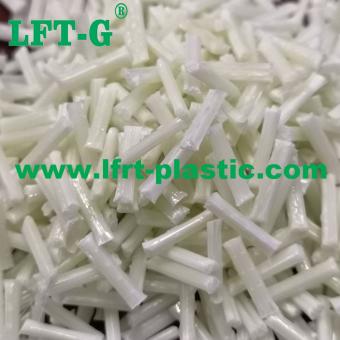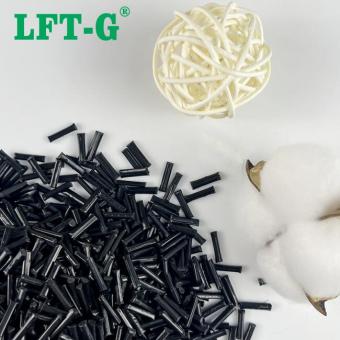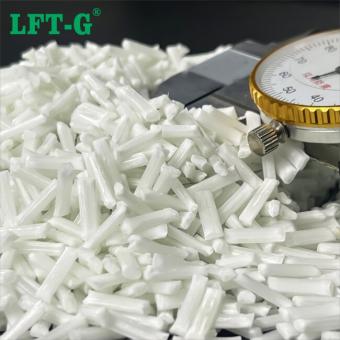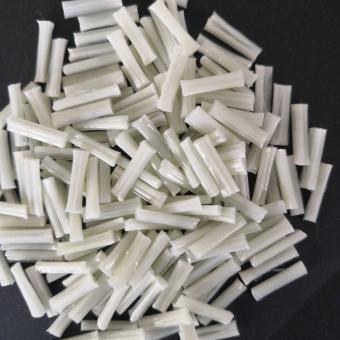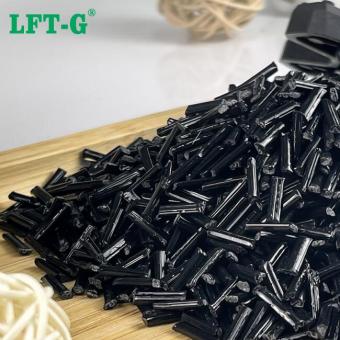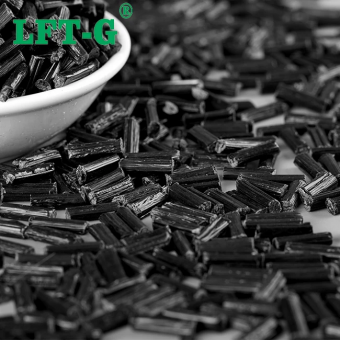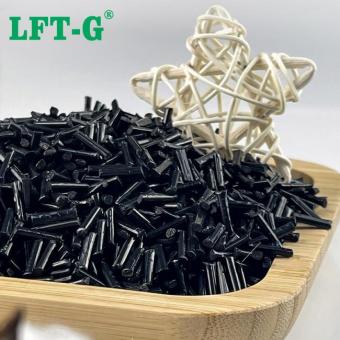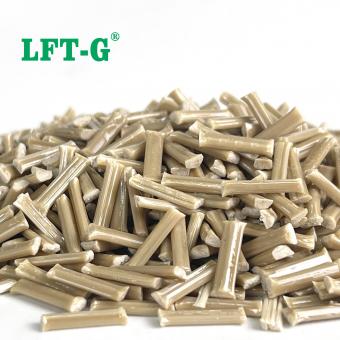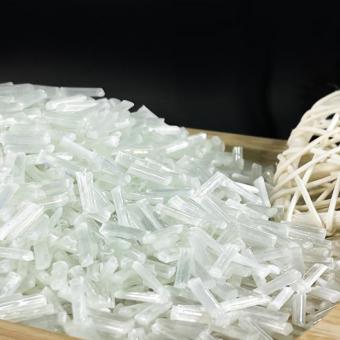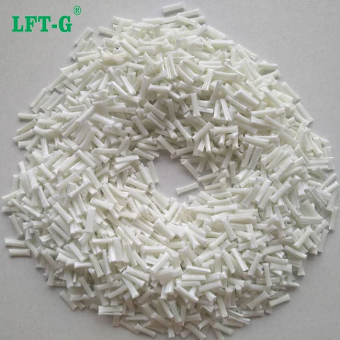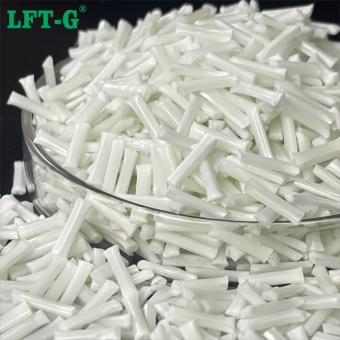-
LFT High Density Polyethylene Long Glass Fiber 20%-60% high toughness pellets 12mm lengthHDPE High density polyethylene (HDPE), a granular product. Non-toxic, odorless, crystallinity of 80% ~ 90%, softening point of 125 ~ 135 ℃, the use of temperature up to 100 ℃; hardness, tensile strength and creep is better than low-density polyethylene; wear resistance, electrical insulation, toughness and cold resistance is better; good chemical stability, at room temperature, insoluble in any organic solvents, resistant to corrosion of acids, alkalis and various salts. Long glass fiber Glass fiber reinforced plastic is based on the original pure plastic, adding glass fibers and other additives, so as to improve the scope of use of the material. Generally speaking, most of the glass fiber reinforced materials are used in the structural parts of the products, which is a kind of structural engineering materials, such as: PP, ABS, PA66, PA6, HDPE, PPA, TPU, PEEK, PBT, PPS and so on. Advantages After glass fiber reinforcement, glass fiber is a high temperature resistant material, therefore, the heat-resistant temperature of reinforced plastics is much higher than before without glass fiber, especially nylon plastics. After the glass fiber reinforcement, due to the addition of glass fiber, the plastic polymer chain is restricted to move with each other, therefore, the shrinkage of reinforced plastics decreases a lot, and the rigidity is greatly improved. After glass fiber reinforced, the reinforced plastic will not stress cracking, at the same time, the impact resistance of the plastic improves a lot. After the glass fiber reinforcement, the glass fiber is a high strength material, which also greatly improves the strength of the plastic, such as: tensile strength, compression strength, bending strength, improve a lot. After glass fiber reinforcement, due to the addition of glass fiber and other additives, the combustion performance of the reinforced plastics decreases a lot, most of the materials can not be ignited, it is a kind of flame-retardant material. Datasheet Contact us
- HDPE compounds white color
- high performance hdpe modified plastic
- injection molded plastic virgin
- hdpe pellets polymer resins underground pipe
- engineering plastic can be recycled
- hdpe fittings best price 25kg/bag
Tags :
-
LFT Nylon MXD 6 compounds filled long glass fiber high performance modified plasticMXD6 materials MXD6 is a crystalline polyamide resin, which is synthesized by condensation of m-phenylenedimethylamine and adipic acid. 1、Maintain high strength and rigidity in a wide temperature range 2、High heat deflection temperature, small coefficient of thermal expansion 3、Low water absorption, small size change after water absorption, less mechanical strength reduction 4、Small shrinkage rate of molding, suitable for precision molding process 5、Excellent paintability, especially suitable for surface painting under high temperature 6、Excellent barrier to oxygen, carbon dioxide and other gases MXD6-LGF materials MXD6 can be laminated with glass and carbon fibers for materials containing 20-60% glass fiber reinforcement with exceptional strength and stiffness. Even when filled with high levels of glass fiber, its smooth, resin-rich surface creates a high gloss surface as without glass fiber, making it extremely suitable for painting, metal coating or generating naturally reflective shells. 1. High fluidity for thin wall It is a very high flowing resin that can easily fill thin walls as thin as 0.5 mm thick even with glass fiber content as high as 60%. 2. Excellent surface finish The resin-rich perfect surface has a highly polished appearance, even with a high glass fiber content. 3. Very high strength and stiffness With 50-60% glass fiber reinforcement, MXD6 has a tensile and flexural strength similar to many cast metals and alloys. 4. Good dimensional stability At ambient temperature, the coefficient of linear expansion (CLTE) of MXD6 glass fiber composites is similar to that of many cast metals and alloys. It is highly reproducible due to low shrinkage and the ability to maintain tight tolerances (length tolerances can be as low as ± 0.05% if properly formed). Datasheet for reference produce processing Extrusion mold Injection mold Frequently asked questions Q. Does long glass fiber and long carbon fiber injection have special requirements for injection molding machines and molds? A. There are certainly requirements. Especially from the product design structure, as well as the injection molding machine screw nozzle and mold structure injection molding process must consider the requirements of long fiber. Q. How to choose the requirement method and length of the material when using long fiber reinforced thermoplastic material? A. The selection of materials depend on the requirements of the products. It is necessary to assess how much the content is enhanced and how much length is more appropriate, which are depending on the performance of the products. Q. Under what circumstances can long fiber replace short fiber? What are the common alternative materials? A. Traditional staple fiber materials can be replaced with long glass fiber and long carbon fiber LFT materials in the case of customers whose mechanical properties cannot be met or where higher metal substitutes are desired. For example, PP long glass fiber is often replacing nylon reinforced glass fiber, and nylon long glass fiber is replacing PPS series. We will offer you 1. LFT & LFRT material technical parameters and leading edge design 2. Mold front design and recommendations 3. Provide technical support such as inejction molding and extrusion molding Main products
- China factory made engineering plastic
- low warping water absorption MXD6
- meto-xylenediamine and adipic acid.
- Nylon-Mxd6 fibre glass 20%-60% content
- instead metal and steel lightweight plastic
- MXD nylon sample available granules
Tags :
-
LFT-G High Quality Nylon Polyamide 6 Long Carbon Fiber Reinforced PlasticsPolyamide 6 Profile PA66+LGF60 Polytron A60N01 is Natural, 60% Long Glass Fiber Reinforced, Heat Stabilized POLYAMIDE 66, The Glass Fibers are Chemically Coupled to the Polymer Matrix, The material is supplied in pellets that are typically 12mm in length. Fiber length is the length of the pellets. Typical applications include Injection Molding Applications. Production Process of LGF 1. Through the physical and chemical treatment of the original carbon fiber, it removes impurities, improves surface activity, and provides the mechanical properties and durability of pre-soaked materials. 2. Add resin, additives, etc., form a unique formula. Improve flowability, hardness, temperature stability. 3. The pre-treated carbon fiber is placed on the machine, and the resin is evenly covered on its surface. 4. Use the machine to solidify the material, and the fiber and resin are both sufficiently bonded. 5. According to the requirements of the product, cutting particles. What are the advantages and applications of Polyamide 6? Nylon 6 fibers are tough, possessing high tensile strength, elasticity, and luster. The fibers can absorb up to 2.4% of water, although this lowers tensile strength. The glass transition temperature of nylon 6 is 47 °C. Nylon 6 is generally white as a synthetic fiber but can be dyed in a solution bath before production for different color results. The tenacity of nylon 6 is 6–8.5 gf/D with a density of 1.14 g/cm3. Its melting point is 215 °C and can protect heat up to 150 °C on average. The applications of nylon 6 include construction material in many industries, including the automotive industry, electronic and electrotechnical industry, aircraft industry, clothing industry, and medicine. The advantages of nylon 6 are that its fibers are wrinkleproof and highly resistant to abrasion and chemicals such as acids and alkalis. Long fiber reinforced thermoplastics are an excellent option to consider for metal replacement at a fraction of the weight. About Xiamen LFT laboratory Warehouse Xiamen LFT has capabilities to provide assistance to you throughout an entire product launch - through product discussion, performance analysis, composite selection, composite pellet production, after-sales tracking. In addition, we provide guidance on injection molding techniques
- PA6 GFRP engineering plastic
- Manufacturer directly sell good price plastic
- Thermoplastic resin modified polymers
- customization service
- car parts lightweight instead metal
- composites made in China high toughness
Tags :
-
Xiamen LFT Polypropylene Copolymer High Impact Resistance Long Glass Fiber FilledWhat Is Copolymer? A copolymer is a polymer made up of more than one type of monomer unit. Copolymers are produced by polymerizing two or more types of monomer together in a process referred to as copolymerization. Copolymers produced in this way are sometimes also referred to as biopolymers. What Is the Purpose of Copolymer? The purpose of creating a copolymer is to manufacture a polymer with more desirable properties. Copolymers typically experience a lower crystallinity, higher glass transition temperature, and improved solubility. These characteristics are achieved through a process referred to as rubber toughening. Where Are Copolymers Used? Copolymers can be found in many industries, including in: Car parts, washing machine parts, water pump parts, water treatment components, furniture parts, etc. What Are the Advantages of Copolymer? The advantages of using copolymers include: 1.High shear resistance. 2.High operating temperature. 3.High corrosion resistance. 4.High impact resistance. 5.High dimensional stability. What is the Application of Polypropylene Long Glass Fiber Reinforcement? LFT-G production process LFT® is A LGF or LCF compound , through Centerfill manufacturing method which Offers exceptional Properties for weight and Cost reduction. With pellet length of 7-25mm and a range of 20%-70% of LGFor LCF content , LFT® Products family consist of Tailor made solutions to the Industry’s vast requirements , such as: LFT® - Fulfills heat stability requirements. LFT® - Offer Climate resistant Properties including UV resistance. LFT® - Ultra Performance & safety , with exceptional impact resistance Features, especially at low temperatures. LFT® - Cost Effective P.s. Centerfill manufacturing method:Centerfill uses our proprietary technology to introduce glass roving (GFR), which consists of several thousand filaments, into an impregnating device and melt the thermoplastic resin, uniformly impregnating between the filaments and then cutting them into pellets. Manufacture. Q & A Q. What are the differences and advantages of long fiber materials and staple fibers? A:Long-fiber reinforced composites show excellent mechanical properties compared to short fibers and are more suitable for applications requiring high strength. The impact performance of long fiber composites is 1-3 times higher than that of short fibers, tensile strength is more than 50% higher, and mechanical properties are 50-80% higher. Q. The product is easy to brittle, so changing to use long fiber reinforced thermoplastic materials can solve this problem? A: The overall mechanical properties must be improved. The characteristics of long glass fiber and long carbon fiber are the advantages in mechanical properties. It has 1-3 times higher (toughness) than short fiber , and the tensile strength(strength and rigidity) is increased by 0.5-1 times. Q. Using a more long fiber reinforced thermoplastic material, will it block the die hole due to the long length of the fiber or not ? A: When using long glass fiber or long carbon fiber, it is necessary to evaluate whether the product is suitable for LFT-G. If the product is too small or the dispensing is not suitable for long fiber materials. The long fiber itself has requirements for the mold nozzle. About Xiamen LFT Xiamen LFT Composite Plastic Co.,LTD was established in 2009, is a brand-name global suppliers of long fiber reinforced thermoplastic materials integrating product research & developmen (R&D), production and sale marketing. Our LFT products have passed the ISO9001&16949 system certification and have obtained lots of national trademarks and patents, covering the fields of automotive, military parts and firearms, aerospace, new energy, medical equipment, power wind energy, sports equipment, etc.
- LGF Glass Fiber Reinforced Thermoplastic Resin
- Manufacturer sell automovtive parts
- High quality raw materials
- Engineering Plastic Compounds Pellets
- High Mechanical Performance Hybrid Composites
- Can be recycled no toxic
Tags :
-
LFT-G Polyphthalamide PPA compounds Long Glass Fiber Reinforced PelletsWhat is the PPA material? PPA is polyphthalamide. PPA is a kind of thermoplastic functional nylon with both semi-crystalline structure and non-crystalline structure. It is prepared by polycondensation of phthalic acid and phthalenediamine. It has excellent thermal, electrical, physical and chemical resistance and other comprehensive properties. It still has excellent mechanical properties, including high rigidity, high strength, high dimensional accuracy, low warping and stability, fatigue resistance and creep resistance, under the harsh working environment of continuous high temperature, humidity, oil pollution and chemical corrosion at 200℃. What is the PPA-LGF? Long glass fiber reinforced composites can solve your problems when other methods of reinforced plastics do not provide the performance you need or if you want to replace metal with lower price plastic. Long glass fiber reinforced composites can cost-effectively reduce the cost of goods and effectively improve the mechanical properfies of engineering polymers, and increase the durability by forming long fibers to form a long - fiber - reinforced internal skeleton networkl. Performance is preserved in a wide range of environments. What is the difference compared with Short glass fiber compounds? What is the application of PPA-LGF? Bicycle accessories Mechanical parts Drive belt pulley For other applications filed please contact us, and we will give you technical support. Datasheet for reference only Certifications Quality Management System ISO9001/16949 Certification National Laboratory Accreditation Certificate Modified Plastics Innovation Enterprise Heavy metal REACH & ROHS testing Contact us, for more LFT materials
- instead of metal and steel good price
- thermoplastic resin PPA lgf
- plastic reinforced glass fiber
- PPA filled long glass fiber plastic
- ppa composite lgf engineering plastic
- injection molding lft lightweight
Tags :
-
Xiamen LFT Polyamide 12 Long Carbon Fiber Composite Nylon Pellets PolymerLFT PA12 Long Carbon Fiber Composite Data Sheet and Technical Guidance
- Long Carbon Fiber Composite high strength
- LFT PA12 Long Carbon Fiber for car parts
- Nylon 12 Pellets Polymer engineering plastic
- PA12 Granules thermoplastic resin instead metal
- Pa12 Pellets Polyamide lightweight
- PA12 Long Carbon Fiber Composite
Tags :
-
Xiamen LFT Flame Resistance Polyphenylene Sulfide Long Carbon Fiber Reinforced CompoundsPolyphenylenesulfide, is a thermoplastic special engineering plastic with excellent comprehensive properties.
- pps fiber special thermoplastic resin
- Engineering plastics high mechanical properties
- new materials instead metal steel
- Injection molding made in China plastic
- demanding industrial applications
- carbon fiber natural color enhanced
Tags :
-
Xiamen LFT high performance Polyphenylene Sulfide Long Glass Fiber Reinforced Thermoplastic PolymersPPS is a high-performance, tough engineering plastic with great dimensional and thermal stability, as well as a wide operating temperature range of up to 260 °C and good chemical resistance. Moreover, PPS, like most other thermoplastics, is an electrical insulator. Its ability to be used at high temperatures coupled with its thermal stability makes PPS great for applications such as semiconductor components in machinery, bearings, and valve seats. About PPS-LGF compounds PPS plastic (polyphenylene sulfide), English name: Polyphenylenesulfide, is a thermoplastic special engineering plastic with excellent comprehensive properties. Its outstanding features are high temperature resistance, corrosion resistance and superior mechanical properties. The product will make a metallic sound when it is dropped to the ground. . Pure PPS is rarely used alone due to its brittle performance. Most of the PPS used is its modified variety. Glass fiber reinforced PPS is one of them. PPS lengthened glass fiber (LGF) composite material has the advantages of high toughness, low warpage, fatigue resistance, and good product appearance. It can be used in water heater impellers, pump casings, joints, valves, chemical pump impellers and casings, cooling water impellers and Shells, home appliance parts, etc. Automotive industry Applications: Due to its excellent mechanical properties, thermoplastic carbon fiber is widely used in the automotive field of fuel system components, sensors, shell components. On the one hand, it is because of the high strength and stiffness of PPS-LCF, and the finished parts are not easy to damage. On the other hand, PPS-LCF also has a relatively low coefficient of thermal expansion to ensure the stability of the finished product. In addition, PPS-LCF also has very good corrosion and heat resistance, making the application life of the finished product longer. Industrial Applications: In the industrial field, it is mainly used in the parts of equipment, such as chemical processing equipment, air pumps, gaskets, valves, etc. In addition to the high strength of the PS-LCF, it is also because the parts made by the PS-LCF have very good self-lubricating properties, which is very important for mechanical parts. Therefore, compared with the traditional carbon fiber material products, the performance has been greatly improved. The wide range of applications of PPS-LCF include aerospace, automotive manufacturing, electronic equipment, chemical and medical fields. Basic Performance of PPS-LGF 1 Excellent overall performance. PPS resin is a crystalline polymer with high hardness. Its crystal content is about 65% and its density is 1.34g/cm^3. It has excellent mechanical properties. Its tensile strength and bending strength are better than those of PA, PC, PBT, etc. It has extremely high rigidity and creep resistance. The mechanical properties will better after adding glass fiber reinforcement. 2 Excellent heat resistance. Its melting point can reach 275~291℃, and its heat distortion temperature is 135℃. After glass fiber reinforcement, its heat distortion temperature can reach 260℃. In air, polyphenylene sulfide reaches the weakening temperature at about 400°C, and polyphenylene sulfide begins to decompose in air at 700°C. The long-term use temperature is 200~240℃, and the thermal stability of long-term continuous use is better than all current engineering plastics. 3 The dielectric strength is better. PPS has a symmetrical molecular structure, non-polarity, and low water absorption, so its electrical insulation is very good. Compared with other engineering plastics, its dielectric constant is small, and its arc resistance is equivalent to that of thermosetting plastics. It can be used in high temperature, high humidity, frequency conversion, etc. Under harsh conditions, PPS can still maintain excellent electrical insulation. 4 preservative. Because PPS has a high degree of crystallinity, it has excellent chemical resistance and is insoluble in any organic solvent below 200°C. In addition to strong oxidizing acids, it can withstand the erosion of various acids, alkalis, and salts. After being soaked in various chemicals for a long time, it still maintains high strength. Materials Details Number PPS-NA-LGF Color Natural color or Customized Length 6-25 mm Package 25kg/bag MOQ 25kg Lead time 2-15 days Port of Loading Xiamen Port Trade terms EXW/FOB/CFR/CIF/DDU/DDP About Xiamen LFT Xiamen LFT Composite Plastic Co.,LTD was established in 2009, is a brand-name global suppliers of long fiber reinforced thermoplastic materials integrating product research & developmen (R&D), production and sale marketing. Our LFT products have passed the ISO9001&16949 system certification and have obtained lots of national trademarks and patents, covering the fields of automotive, military parts and firearms, aerospace, new energy, medical equipment, power wind energy, sports equipment, etc. LFT long fiber reinforced th...
- High performance thermoplastic engineering plastics
- excellent heat resistance with filler
- injection molding products light weight
- High temperature and corrosion resistance
- modified plastic manufacturer can be customized
- can be recylced GFRP GF30
Tags :
-
Xiamen LFT Thermoplastic Polyurethane (TPU) Long Glass Fiber Reinforced Thermoplastic CompoundsThermoplastic Polyurethane is soft and elastic, with excellent tensile and tear strength. For this reason, it is often used to make parts that demand a rubber-like elasticity. TPU is a little bit expensive than other resins, but there is no substitute for many applications, such as protective wire and cable sheaths. Another advantage is that TPU improves the grip for products that need to be held securely in hand. About TPU-LGF compounds What Products Are Best Manufactured via Thermoplastic Polyurethane (TPU)? Some of the TPU products manufactured are automotive instrument panels, caster wheels, sporting goods, power tools, drive belts, medical devices, footwear and etc. What is Thermoplastic Polyurethane (TPU) for Plastic Injection Molding? ETPU is a tough, highly abrasion-resistant resin that bridges the gap between rubbers and plastics. TPUs can be formulated to be rigid or elastomeric. TPU exhibits a high flex before break and is ideal for wheels and door panels. What is the Molding Temperature for Thermoplastic Polyurethane (TPU)? depending on the TPU being molded. Materials Details Number TPU-NA-LGF Color Natural color or Customized Length 6-25 mm Package 25kg/bag MOQ 25kg Lead time 2-15 days Port of Loading Xiamen Port Trade terms EXW/FOB/CFR/CIF/DDU/DDP About Xiamen LFT Xiamen LFT Composite Plastic Co.,LTD was established in 2009, is a brand-name global suppliers of long fiber reinforced thermoplastic materials integrating product research & developmen (R&D), production and sale marketing. Our LFT products have passed the ISO9001&16949 system certification and have obtained lots of national trademarks and patents, covering the fields of automotive, military parts and firearms, aerospace, new energy, medical equipment, power wind energy, sports equipment, etc. LFT long fiber reinforced thermoplastic engineering materials,compared to ordinary short fiber reinforced thermoplastic materials (fiber length is less than 1-2 mm), the LFT process produces thermoplastic engineering material's fibers in lengths of 5-25 mm. The long fibers are impregnated with the resin through a special mold system to obtain long strips that are fully impregnated with the resin ,and then cut to the length as required. The most used base resin is PP, by PA6, PA66, PPA,PA12,MXD6,PBT,TPU,PPS, ABS,PEEK, etc. Conventional fibers include glass fiber, carbon fiber. Depending on the end use, the finished products can be used for injection molding,extrusion, molding, etc., or directly used for plastic instead of steel and thermoset products.view more
-
Xiamen LFT ABS (Acrylonitrile Butadiene Styrene) Long Glass Fiber Reinforced Thermoplastic CompoundsABS is another preferred type of engineering plastic that is valued for its chemical and thermal stability, strength, toughness, and glossy finish. Its host of desirable properties make it a versatile material. It is used in everything from consumer products like toys and bicycle helmets to automotive applications such as interior trim pieces, housings for electronics, and more. After adding glass fiber to ABS, the rigidity, heat resistance and dimensional stability of the composite are significantly improved. In addition, the cost performance of ABS plus glass fiber is extremely good, which can meet the needs of manufacturers while reducing costs. About ABS-LGF compounds The main application scope of modified ABS: 1. Auto parts: instrument panels, fenders, car interiors, car lights, reversing mirrors, car audio; 2. Electronic and electrical components: IT equipment, OA equipment shells, converters, etc., power sockets, etc.; 3. Electronic appliances: switches, power switches, controllers, monitors, monitor housings, electrical housings, electrical brackets; 4. Home appliances: electrical components, electrical control boxes What Are the Advantages of ABS Injection Molding? The advantages of ABS injection molding are: 1. High Productivity - Efficiency Injection molding is a highly efficient and productive manufacturing technology and is the preferred method of manufacturing ABS parts. The process creates limited waste and can produce large volumes of parts with limited human interaction. 2. Design of Complex Parts Injection molding can produce multi-featured, complex components that can include metal inserts or overmolded soft-grip handholds. 3. Increased Strength ABS is a strong, lightweight thermoplastic that is widely used in a number of industries due to these properties. As such, injection molding in ABS is ideal for applications that require increased durability and overall mechanical strength. 4. Flexibility of Color and Material ABS is easily colored with a wide range of colors. It must be noted however that ABS has poor weathering resistance and can be degraded by UV light and prolonged outdoor exposure. Fortunately, ABS can be painted and even electroplated with metal to improve its environmental resistance. 5. Decreased Waste Injection molding is inherently low-wastage production technology due to the large production volumes that injection molding was designed for. When millions of parts are made per year, any amount of wastage adds up to a significant cost over time. The only wastage is the material in the sprue, runners, and the flashing between mold halves. 6. Low Cost of Labor Due to the highly automated nature of injection molding, very limited human intervention is required. Reduced human intervention results in reduced labor costs. This reduced labor cost ultimately results in a low cost per part. Materials Details Number ABS-NA-LGF Color Natural color or Customized Length 6-25 mm Package 25kg/bag MOQ 25kg Lead time 2-15 days Port of Loading Xiamen Port Trade terms EXW/FOB/CFR/CIF/DDU/DDP About Xiamen LFT Xiamen LFT Composite Plastic Co.,LTD was established in 2009, is a brand-name global suppliers of long fiber reinforced thermoplastic materials integrating product research & developmen (R&D), production and sale marketing. Our LFT products have passed the ISO9001&16949 system certification and have obtained lots of national trademarks and patents, covering the fields of automotive, military parts and firearms, aerospace, new energy, medical equipment, power wind energy, sports equipment, etc. LFT long fiber reinforced thermoplastic engineering materials,compared to ordinary short fiber reinforced thermoplastic materials (fiber length is less than 1-2 mm), the LFT process produces thermoplastic engineering material's fibers in lengths of 5-25 mm. The long fibers are impregnated with the resin through a special mold system to obtain long strips that are fully impregnated with the resin ,and then cut to the length as required. The most used base resin is PP, by PA6, PA66, PPA,PA12,MXD6,PBT,TPU,PPS, ABS,PEEK, etc. Conventional fibers include glass fiber, carbon fiber. Depending on the end use, the finished products can be used for injection molding,extrusion, molding, etc., or directly used for plastic instead of steel and thermoset products.view more
-
Xiamen LFT Nylon Polyamide 6 Long Glass Fiber Reinforced Thermoplastic CompoundsWhy Use Polyamide? The reason behind choosing polyamide over other materials will vary for different applications. When using polyamide for electrical cable protection, it offers better performance, flexibility, and impact resistance than PVC protection. In the automotive industry, it is used because it is cheaper and lighter than metal. In machines, it is used over other materials due to its high flexibility and durability. About PA6-LGF compounds The main application scope of modified PA6: 1. Auto parts: instrument panels, fenders, car interiors, car lights, reversing mirrors, car audio; 2. Electronic and electrical components: IT equipment, OA equipment shells, converters, etc., power sockets, etc.; 3. Electronic appliances: switches, power switches, controllers, monitors, monitor housings, electrical housings, electrical brackets; 4. Home appliances: electrical components, electrical control boxes What Are the Advantages of Nylon 6? The main advantages of nylon 6 are its stiffness and resistance to abrasion. Moreover, this material has excellent impact strength, wear resistance, and electrical insulating properties. Nylon 6 is a highly elastic and fatigue-resistant material, meaning it will return to its original proportions after being distorted by tension. This polyamide is non-toxic and can be combined with glass or carbon fibers to increase performance. The absorption capacity of the material grows in direct proportion to the quantity of moisture it absorbs. The high affinity of nylon 6 for some dyestuffs allows for more dyeing diversity, with the potential for brighter, deeper patterns. Materials Details Number PA6-NA-LGF Color Natural color or Customized Length 6-25 mm Package 25kg/bag MOQ 25kg Lead time 2-15 days Port of Loading Xiamen Port Trade terms EXW/FOB/CFR/CIF/DDU/DDP About Xiamen LFT Xiamen LFT Composite Plastic Co.,LTD was established in 2009, is a brand-name global suppliers of long fiber reinforced thermoplastic materials integrating product research & developmen (R&D), production and sale marketing. Our LFT products have passed the ISO9001&16949 system certification and have obtained lots of national trademarks and patents, covering the fields of automotive, military parts and firearms, aerospace, new energy, medical equipment, power wind energy, sports equipment, etc. LFT long fiber reinforced thermoplastic engineering materials,compared to ordinary short fiber reinforced thermoplastic materials (fiber length is less than 1-2 mm), the LFT process produces thermoplastic engineering material's fibers in lengths of 5-25 mm. The long fibers are impregnated with the resin through a special mold system to obtain long strips that are fully impregnated with the resin ,and then cut to the length as required. The most used base resin is PP, by PA6, PA66, PPA,PA12,MXD6,PBT,TPU,PPS, ABS,PEEK, etc. Conventional fibers include glass fiber, carbon fiber. Depending on the end use, the finished products can be used for injection molding,extrusion, molding, etc., or directly used for plastic instead of steel and thermoset products.view more

 e-mail
e-mail English
English français
français Deutsch
Deutsch русский
русский italiano
italiano español
español português
português العربية
العربية 日本語
日本語 한국의
한국의 中文
中文












